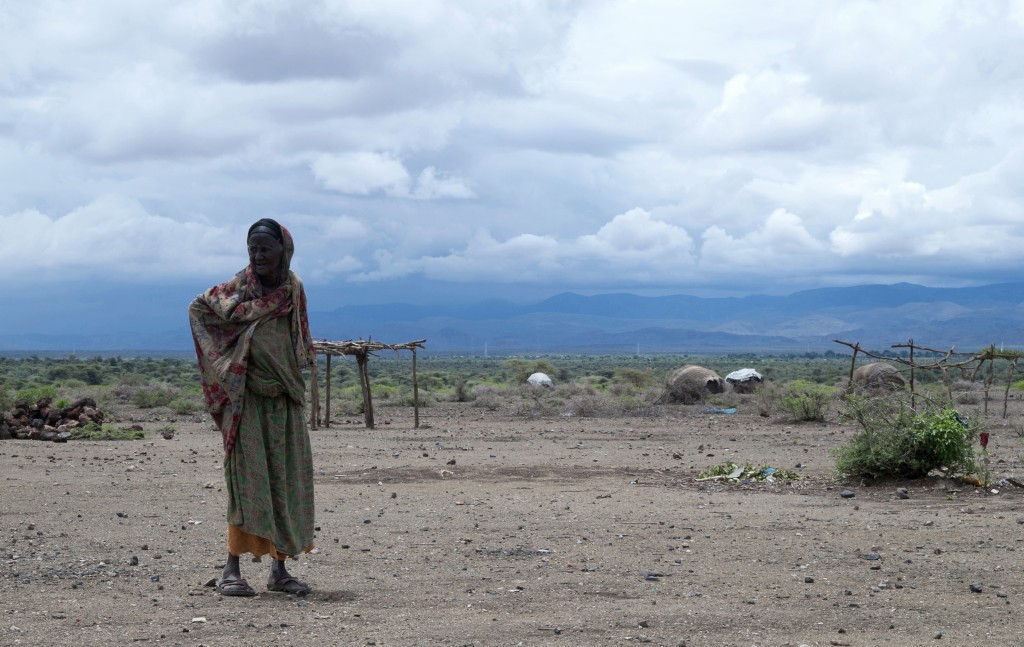
Stuck on a track in eastern Ethiopia, trucks carrying food for the starving are forced to turn back. After one of the worst droughts for decades, the rains have finally arrived, but now only add to the complication of the delivery of food aid. / AFP PHOTO /
by Karim LEBHOUR
DERALA , Ethiopia (AFP) — Stuck on a track in eastern Ethiopia, trucks carrying food for the starving are forced to turn back.
After one of the worst droughts for decades, the rains have finally arrived, but now only add to the complication of the delivery of food aid.
Flash floods have effectively transformed dry dirt tracks into impassable quagmires, adding to the woes of the victims in remote areas, some of whom have received no help for weeks.
A year of drought has pushed 10.2 million Ethiopians into dire conditions needing food aid to survive, according to the United Nations.
Here in Sitti province, in the far east of the Horn of African nation, times were tough even before the drought. The region is classified as “emergency”, according to UN monitors, one step short of famine.
In the small village of Derela, cattle herders come from far for aid. Dozens of carcasses of goats and cattle testify to the magnitude of the drought.
“All my animals died,” said Ali Boor, installed in a makeshift camp with his wife and their seven children. From his 200 cows, only six survived.
“Without any help, there was no hope,” he said. “We heard that here we could have food and water.”
Floods and failed rains caused by the El Nino weather phenomenon have sparked a dramatic rise in the number of people going hungry in large parts of Africa, with southern Ethiopia an area of especial concern.
Food and funding gaps
Food insecurity is a sensitive issue in Ethiopia, which enjoys near-double-digit economic growth, but which has struggled to change its image following the famine of 1984-85 which followed an extreme drought.
“A drought like this is unheard of,” added Mohamed Aden, the leader of the community, a few huts away. In two years, three consecutive seasons of rains were abnormally low, a situation attributed to El Nino.
“At the beginning, we sold the livestock to buy food. Without help, we would have only the skin of animals to eat,” said Aden.
Children receive a bowl of porridge a day at school, and their families get wheat rations distributed by the UN, often irregularly.
Despite these efforts, malnutrition has reached grim levels: 350,000 children under five years were treated for severe malnutrition in Ethiopia in 2015, a figure expected to reach 450,000 in 2016, according to the UN children’s agency UNICEF.
In Malkashek, amidst a vast expanse of desert, the mobile clinic set up by Save the Children is always busy.
Aid worker Abd Rahman Adan measures the children to identify the most malnourished. Last month, 136 cases of severe malnutrition were registered in this district alone.
“Since the beginning of the drought, we have seen many more cases of malnutrition,” said Adan, who hands out packets of super-sweet and specially fortified peanut paste.
“Some children regain a normal weight, but others must be sent to a stabilisation centre,” he added.
Last hope’
Aisha Nour, the mother of a malnourished two-year-old girl leaves with a few packs of food supplements and bags of wheat loaded onto a donkey. “We eat pancakes from sorghum and wheat, that’s all, no milk or oil,” she said.
The rains are making things worse.
“Roads are turning into raging rivers and our trucks carrying food assistance are unable to reach many communities,” warned the Norwegian Refugee Council (NRC) aid agency.
Weakened without water and food, the lashing cold rains are now killing the livestock that provides for many people their last lifeline.
“The rain has led to livestock deaths that in their weakened state are more susceptible to illnesses. For many this was the last hope they had,” said Mohamed Hassan, NRC operations chief in the eastern Jigjiga district.
Faced with the food crisis, the Ethiopian government has allocated $766 million in emergency aid. Donor countries have also promised aid, but there is still a worrying $600 million shortfall from the $1.4 billion needed.
“The Middle East and the migrant crisis has diverted attention from our partners,” said Minister for Food Security Mitiku Kassa.
Aid agencies are worried too.
“Last year, many farmers had little or no harvest,” said Save the Children’s chief in Ethiopia, John Graham.
“There are millions of people who will be increasingly hungry until the next harvest, September at the earliest.”
© 1994-2016 Agence France-Presse








